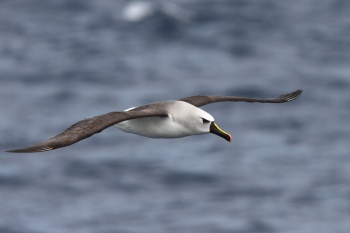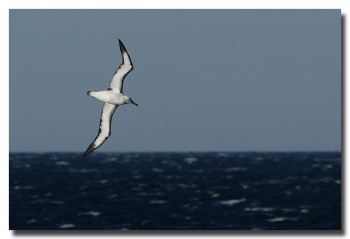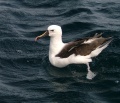Alternative name: Yellow-nosed Mollymawk

Photo © by Tiger1
Southern Ocean south of Albany, Western Australia, 28 July 2012.
- Thalassarche chlororhynchos
Identification
Length 71-82 cm (28-32¼ in). Wingspan 180-210 cm.
The smallest southern albatross but similar to other mollymawks.

Photo © by Adam Riley
Southern Ocean off Cape Town, South Africa, 15 October 2011
Adult: back blackish-grey, upperwings blackish, rump white, tail dark grey and underparts white. Head grey with white nape and hindneck. Under-wing white with black tip and clear-cut margins, broadest on leading edge. Iris brown, bill black with yellow culminicorn and pinkish tip, legs bluish-pink.
Immature: as adult but head whiter and bill all-dark.
Variations
T. c. chlororhynchos: the yellow bill stripe ends in a curve at the forehead, but is pointed in T. c. bassi. Also the Atlantic bird shows a greyish wash around the neck while the Indian one is pure white.
Similar Species
Identified by combination of bill-colour and underwing pattern which is intermediate between Black-browed D. melanophris and Shy D. cauta.
Distribution
South Atlantic and southern Indian Oceans. Breeds on Tristan da Cunha and Gough (St. Helena), St Paul, Amsterdam, Prince Edward and Crozet Islands. After breeding disperses to South Atlantic and Indian Oceans between 15 and 45 degrees south. The commonest albatross off eastern South Africa in May-September and off southern Western Australia in May-October where occurs north to Point Cloates.
Vagrants recorded in the Gulf of Mexico and off the eastern seaboard of the USA as far north as Quebec. Also reported from the north-east Atlantic but there are no currently accepted records.
Taxonomy
Diomedea vs. Thalassarche
Genera Phoebastria and Thalassarche formerly placed in the Diomedea, but now considered by virtually all authorities (Clements, Howard & Moore, AOU, BOU, SACC) to be separate genera in light of Nunn et al. (1996) [4] and Penhallurick & Wink (2004) [5].
Subspecies
Two subspecies recognised[1]:
- T. c. chlororhynchos:
- Breeds on Tristan da Cunha and Gough islands; ranges southern oceans
- T. c. bassi:
- Breeds on southern Indian Ocean islands; ranges southern oceans
T.c. bassi is sometimes separated as a separate species, Indian Yellow-nosed Albatross, by some authorities. There is an ongoing discussion whether bassi or carteri is the correct scientific name for this form.[1][3][6]
Habitat
Colonial breeder on cliffs of remote islands and present from August until May, otherwise at sea. Sometimes follows ships.
Behaviour
Breeding
Breeds in southern summer with egg-laying starting in mid-September. Nest is a large bowl made of mud and vegetable matter. Single egg, white marked with brown at larger end (96 x 62mm). Incubated by both parents for about 55-60 days and young fed by both parents. Fledges after 5 months.
Diet
Squid and fish, sometimes refuse from ships.
Vocalisation
Bleating calls and bill-clapping in display, coughing and grunting sounds when competing for food at sea.
Gallery
Click on photo for larger image
Photo © by MikeMules
References
- Clements, J. F., T. S. Schulenberg, M. J. Iliff, D. Roberson, T. A. Fredericks, B. L. Sullivan, and C. L. Wood. 2017. The eBird/Clements checklist of birds of the world: v2017, with updates to August 2017. Downloaded from http://www.birds.cornell.edu/clementschecklist/download/
- BirdLife International. 2017. Thalassarche chlororhynchos (amended version of 2016 assessment). The IUCN Red List of Threatened Species 2017: e.T22698425A111460918. http://dx.doi.org/10.2305/IUCN.UK.2017-1.RLTS.T22698425A111460918.en. Downloaded on 17 June 2018.
- Carboneras, C., Jutglar, F. & Kirwan, G.M. (2018). Atlantic Yellow-nosed Albatross (Thalassarche chlororhynchos). In: del Hoyo, J., Elliott, A., Sargatal, J., Christie, D.A. & de Juana, E. (eds.). Handbook of the Birds of the World Alive. Lynx Edicions, Barcelona. (retrieved from https://www.hbw.com/node/52508 on 18 June 2018).
- Nunn, G. B., J. Cooper, P. Jouventin, C. J.R. Robertson and G. G. Robertson. 1996. Evolutionary relationships among extant albatrosses (Procellariiformes: Diomedeidae) established from complete cytochrome-B gene sequences. Auk 113 (4):784-801.
- Penhallurick, J. and M. Wink. 2004. Analysis of the taxonomy and nomenclature of the Procellariiformes based on complete nucleotide sequences of the mitochondrial cytochrome b gene. Emu 104:125-147.
- Robertson, C.J.R. (2002) The scientific name of the Indian Yellow-nosed Albatross Thalassarche carteri. Marine Orn. 30(1): 48–49.
- Avibase
- BF Member observations
Recommended Citation
- BirdForum Opus contributors. (2024) Atlantic Yellow-nosed Albatross. In: BirdForum, the forum for wild birds and birding. Retrieved 24 April 2024 from https://www.birdforum.net/opus/Atlantic_Yellow-nosed_Albatross
External Links
GSearch checked for 2020 platform.1






